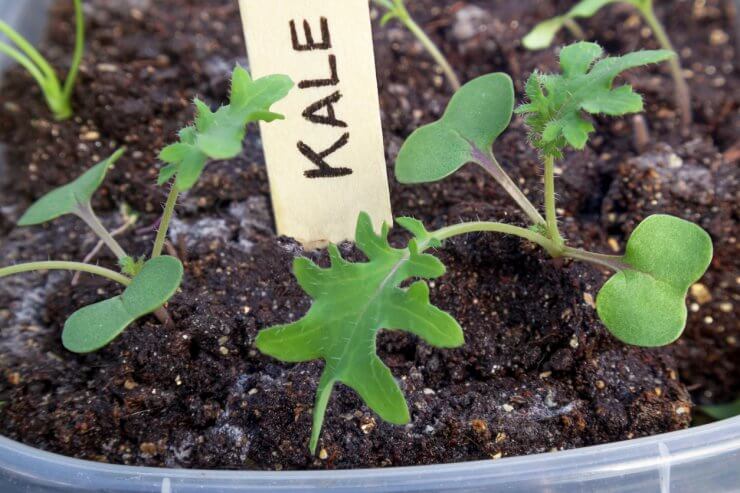
Kale seedlings
Seed Planting Process
Keep in mind that kale loves cool weather. Your timing for planting seeds outdoors or starting seedlings indoors is going to depend on where you garden. In temperate regions, you can actually plant two crops—one in the spring right after the last frost, and again in late summer, about eight to 12 weeks before you expect your first frost. Keep in mind that kale loves water and hates heat. But it also loves a full day of sunlight. Even with this somewhat paradoxical set of requirements, kale is still a very easy vegetable to grow.
As soon as the last spring frost is done and the soil is workable, it’s time to get your seeds in the ground. A quarter-inch furrow is all you need. Space your seeds according to your seed packet directions; in general about a foot or two apart, depending on the variety. A little overlap of kale leaves will actually help shade out weeds, so sometimes close planting can be a good thing. Plus, if you plan to harvest your kale frequently for baby greens salads, you can get away with growing them closer together.
If you’re in a zone with a relatively short growing season, you can get a jump on things by starting your seeds indoors about four weeks before your expected last frost. For a fall crop, start your seedlings in June. Put one or two seeds into a seed cell, cover with a quarter inch of soil, and water gently. Since kale loves cool weather, you shouldn’t need a heated mat like you might with many other plants. Once the seeds have germinated, get out your grow lights. Keep your young seedlings well-watered (but not soggy!).
Keep in mind that you can’t just take your seedlings out of their little seedling cells and plunk them into the ground; the shock could kill them. They need to go through a rite of passage called hardening off. Give your seedlings about five days to be outside for a few hours each day in a sheltered spot, bringing them in at night. Leave them outside longer each day, until they ultimately spend the whole day outside. This process helps strengthen the cells of the plant so it’s ready to take on the great outdoors.
Transplant your seedlings about 8 inches apart, with rows up to 2 feet apart. Remember that kale is a “headless” cabbage, and it likes to spread out. Tailor your planting distance and row spacing according to the variety you’re planting. And if your main mission with growing kale is to have a season full of baby greens, then you can plant your seeds/seedlings closer together.
Growing Kale from Cuttings
It is possible to grow kale from cuttings. If you have a tall, prolific variety that’s getting a little gangly and you’re in the right climate zone where the kale will have time to take root, you can just cut a section off 6 to 12 inches from the top and plunk it into some rich soil (a raised bed or container would be a good choice). The cutting should easily take root and start providing you with more tasty leaves.
Some gardeners swear by this method. Of course, if you have the time to do some succession planting, that’s another option. But in general, providing the proper growing conditions (light, soil, water) can extend your kale crop.
You might want to consider adding some seed starter mix to your soil just to provide a little nutrient boost. Kale is all about producing leaves, so a starter mix that has some nitrogen in it would be a good thing.
Have you tried growing kale from seeds, seedlings, or even cuttings? Which method do you prefer—and why? Please share your experiences with us.


 Previous
Previous

